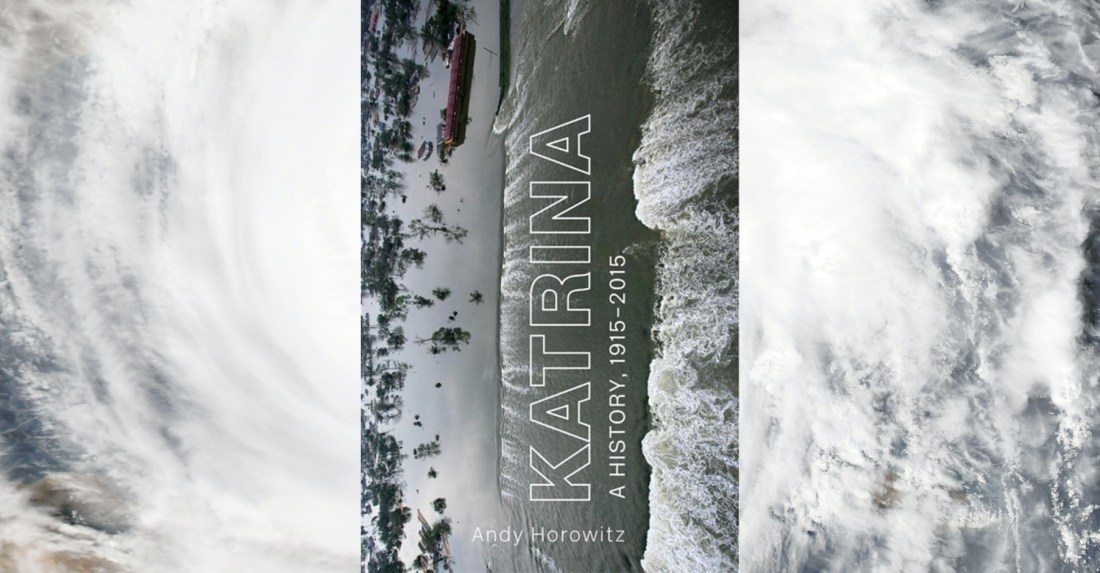Three presidential administrations is a long time in our cultural memory. Someone could easily assume that a 15-year-old disaster like Katrina isn’t immediately relevant to the political issues engaging Americans at the moment. However, Andy Horowitz’s first book, Katrina: A History, 1915-2015, tells a story that is, regrettably, extremely relevant to our current debates regarding climate change, privatization, corruption, race, and inequality. In this thoroughly researched book of history, Katrina becomes an effective and easily comprehensible symbol of the failures of those in power to prevent human suffering, despite having the tools and resources to do so. Horowitz, an Assistant Professor of History at Tulane University, has been writing about disasters and the myths of their inevitability since at least 2011, arguing against the assumption that natural disasters are unforeseeable and unpreventable.
The story of Katrina, in the hands of Horowitz, is at once energizing and horrifying in its clarity and scope. The ease of reading such a dense history immediately shows that the author has been working on this subject with care, discipline, and a deep respect for primary sources for much of his career. The ability we have to prevent many of the effects of natural disaster is well documented, here, as well as our failure to prevent those effects that are caused by mismanagement, dismissal, and greed. Politics, real estate markets, energy production, climate change, racism: these are all covered with responsibility and a focus on fact. And without forgetting the people who experienced the disaster and its impact firsthand.
The writing is sober and focused on facts and analysis of data. Varying from expert reports warning of the consequences of environmental devastation, studies of budget allocations, to descriptions of reactions of the press and the stories of individual residents of New Orleans and greater Louisiana. Focus vacillates naturally from statistics to narrative accounts, both from victims of devastation and those with the power to help.
One of the biggest intentions of this book is attacking the lie that we have little control over our environment. It can be easy to assume that humanity just isn’t powerful enough to change climates, destroy the natural world, or protect ourselves from its destructive power. But when shown the evidence on a smaller scale than the entire planet, it becomes easier to see the real effects we have over the world around us. More recent than the dust bowl and geographically closer than the deforestation of the Amazon, Katrina was and continues to be a meaningful tragedy of irresponsibility, rather than simple incompetence, both during the event and in the aftermath.
But more broadly, this is a story describing the inequalities that the disaster made clear, and how, as the author explains in his introduction, “ideas about natural inequality and nature’s caprice structure American law and social policy.” Horowitz splits the book into two parts. The first describes the decisions that led to New Orleans becoming as flood-prone as it is now, including the destruction of the protective wetlands, the construction of profitable but hazardous canals, and the failure to build infrastructure to effectively prevent flooding. Behind all of these decisions were the assumption that government isn’t responsible for the disasters it allows to happen and even causes, and that the state’s primary responsibility is toward the health of the economy and private enterprises.
Part 1 continues by discussing the failures of disaster relief after Hurricane Betsy, in 1965, and how politicians “welcomed disaster aid not as reparations but as charity, and as a tonic for federal fractures over civil rights. Put another way, Betsy prompted a debate over the causes of inequality and the promises of citizenship.” Part 2 follows the effects of Katrina and the aftermath until 2015. Of course including the abhorrently slow and incompetent response of FEMA, the racist assumptions made by the media, and the unequal nature of disaster relief.
In the end, Katrina: A History, 1915-2015 feels like a call to action. A story of immense human suffering and the partial destruction of a city that is both distinct and vital to American culture. But repeatedly, the evidence shown in this book makes clear that our civilization has everything we need to prevent future harm to those who are vulnerable. I hope you read this book.
Katrina: A History, 1915-2015
by Andy Horowitz
Harvard University Press
Published July 7, 2020


